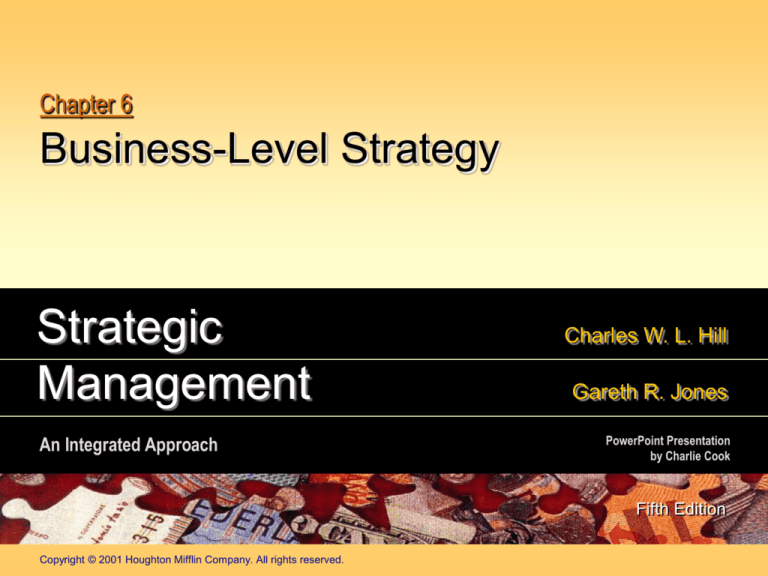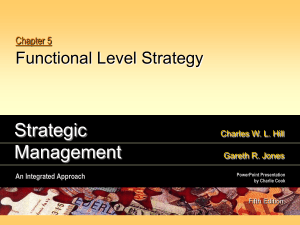
Chapter 6
Business-Level Strategy
Strategic
Management
An Integrated Approach
Charles W. L. Hill
Gareth R. Jones
PowerPoint Presentation
by Charlie Cook
Fifth Edition
Copyright © 2001 Houghton Mifflin Company. All rights reserved.
What Is Business-Level Strategy?
Business-level strategy
A plan of action to use the firm’s resources and
distinctive competencies to gain competitive
advantage.
Abell’s “Business Definition” process
Customer needs – product differentiation (what)
Customer groups – market segmentation (who)
Distinctive competencies – competitive actions (how)
Copyright © 2001 Houghton Mifflin Company. All rights reserved.
6-2
Choosing a Generic Business-Level Strategy
Product/Market/Distinctive-Competency Choices
and Generic Competitive Strategies
Cost Leadership Differentiation
Focus
Product
Differentiation
Low
(principally
by price)
High
(principally by
uniqueness)
Low to high
(price or
uniqueness)
Market
Segmentation
Low
(mass market)
High
(many market
segments)
Low
(one or a few
segments)
Distinctive
Competency
Manufacturing
and materials
management
Research and
development, sales
and marketing
Any kind of
distinctive
competency
TABLE 6.1
Copyright © 2001 Houghton Mifflin Company. All rights reserved.
6-3
Types of Business-Level Strategies
FIGURE 6.1
Copyright © 2001 Houghton Mifflin Company. All rights reserved.
6-4
Choosing a Business-Level Strategy
Cost-leadership strategy success is affected by:
Competitors producing at equal or lower costs.
The bargaining strength of suppliers.
Powerful buyers demanding lower prices.
Substitute products moving into the market.
New entrants overcoming entry barriers.
Copyright © 2001 Houghton Mifflin Company. All rights reserved.
6-5
Choosing a Business-Level Strategy
Differentiation strategy success is achieved
through:
An emphasis on product or service quality.
Innovation in providing new features for which
customers will pay a premium price.
Responsiveness to customers after the sale.
Appealing to the psychological desires of customers.
Copyright © 2001 Houghton Mifflin Company. All rights reserved.
6-6
Choosing a Business-Level Strategy
Differentiation strategy success is affected by:
Competitors imitating features and services.
Increases in supplier costs exceeding differentiator’s
price premium.
Buyers becoming less brand loyal.
Substitute products adding similar features.
New entrants overcoming entry barriers related to
differentiator’s competitive advantage.
Copyright © 2001 Houghton Mifflin Company. All rights reserved.
6-7
Choosing a Business-Level Strategy
Focus strategy success is affected by:
Competitor entry into focuser’s market segment.
Suppliers capable of increasing costs affecting only
the focuser.
Buyers defecting from market segment.
Substitute products attracting customers away from
focuser’s segment.
New entrants overcoming entry barriers that are the
source of the focuser’s competitive advantage.
Copyright © 2001 Houghton Mifflin Company. All rights reserved.
6-8
Strategic Groups and Business-Level
Strategy
Implications for business-level strategy
Immediate competitors are companies pursuing same
strategy within the same strategic group.
Different strategic groups can have a different
standing with respect to the effects of the five
competitive forces.
First mover advantage
Benefits are first choice of customers and suppliers,
setting standards, building entry barriers.
Copyright © 2001 Houghton Mifflin Company. All rights reserved.
6-9
Choosing an Investment Strategy at
the Business Level
Investment strategy
The resources (human, functional, and financial)
required to gain sustainable competitive advantage.
Competitive position
Market share is an indicator of competitive strength.
Distinctive competencies are competitive tools.
Life Cycle Effects
An industry’s life cycle stage affects its attractiveness
to investment prospects.
Copyright © 2001 Houghton Mifflin Company. All rights reserved.
6-10
Choosing an Investment Strategy at the
Business Level
Stage of the
Industry Life Cycle
Strong Competitive
Position
Weak Competitive
Position
Embryonic
Share building
Share building
Growth
Growth
Market concentration
Shakeout
Share increasing
Market concentration or
harvest/liquidation
Maturity
Hold-and-maintain or profit
Harvest or
liquidation/divestiture
Decline
Market concentration or
harvest (asset reduction)
Turnaround, liquidation,
or divestiture
TABLE 6.2
Copyright © 2001 Houghton Mifflin Company. All rights reserved.
6-11



